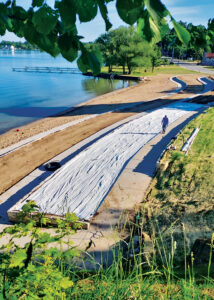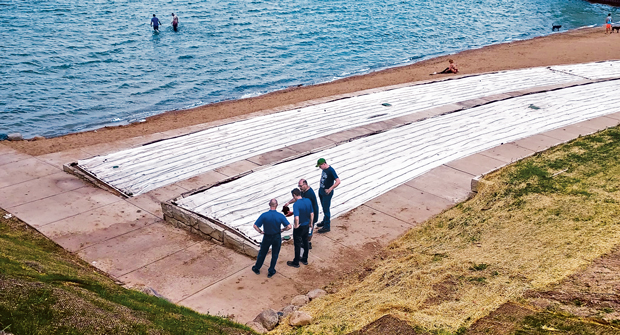Michigan’s Crystal Lake Township Park was in need of a new irrigation system. However, the 5.8-acre community space — complete with a fishing pier, sport courts, beachfronts and grassy areas to enjoy the views — had one issue.
Perfect for walking around or laying down to bask in the sun, this high-traffic area would struggle with a traditional irrigation system that uses sprinkler heads and other above-ground elements. That’s where Ryan Kremsreiter, a commercial irrigation project manager at Grapids Irrigation, came in.
With some collaborations with SiteOne Landscape Supply, Hunter Industries and the local landscaper, Horrocks, he decided to try Hunter’s Eco-Mat subsurface irrigation technology along the terraced park.
“We were kind of like the guinea pigs on that when we learned how to install this. And it really hasn’t been installed in other places to such a scale. It’s usually smaller formats like residential or high-end office (spaces) that’s maybe like 20 feet, 100 feet,” Kremsreiter says. “Nothing to the nature of the scale that we did.”
And the scale was massive — roughly 9,500 feet of Eco-Mat drip irrigation was used to provide a high-quality yet low-maintenance solution that would keep the park looking pristine and clear of obstacles. Kremsreiter says it was one of the largest single-location installments of its kind at the time of its completion last July.

With the project, the client was hoping for an extended beachfront and grassy picnic area next to the lake, and to make it work with this unconventional approach, Grapids Irrigation had to learn on the fly. Kremsreiter says there was a lot to figure out to overcome the initial unfamiliarity.
“The key steps probably started off with making sure we could get that product — getting it sourced — and then making sure that we had an understanding of how much soil would have to be on top of it, how we’d be able place it, then how we were able to essentially run water to each of the areas — really kind of building ourselves a design,” he says.
Being new to this kind of scale also came with some installation challenges to work through. A terraced landscape made moving water and soil tricky, and isolation valves were needed to work on specific areas of the project. Plus, to re-add soil on the terraces without crushing the drip lines, a special excavator was used to sling dirt on top from a distance.
Kremsreiter says the curves in the design also provided a challenge, and his team had to get creative with routing and pre-building some areas to lay down the rolls of Eco-Mat.
“In smaller applications, you’re probably more of like a rectangle or a square, whereas this (had) quite a bit of curves going around, especially on the tail end of it,” he says. “We had to come up with some creative ways to make sure that we got proper coverage.”
Outside of removing the need for sprinkler heads, Eco-Mat’s subsurface technology also provided Crystal Lake with some other benefits. Due to water going directly to the roots, the project can save 20-40 percent on water usage thanks to eliminating sun and wind exposure.
“Eco-Mat was the perfect solution for the Crystal Lake terraced park,” said Brent Snippe, sales manager at Hunter Industries. “It’s engineered to tackle hard-to-irrigate areas by using fleece-wrapped, inline emitter tubing (Eco-Wrap) with specialized fleece. This system evenly distributes water underground, making it ideal for high-traffic areas.”
Kremsreiter says with the successful installation of Eco-Mat, he hopes to help other industry pros understand how they can use this technology. He also praises the people and companies he worked with for turning an unfamiliar tool into the perfect solution for the park.
“The Crystal project was incredibly rewarding,” said Spencer Tellkamp, CEO of Dan’s Excavating, who helped throughout the job. “We moved about 16,000 cubic yards of material to enhance the park’s usability. Eco-Mat helped alleviate concerns about water stains and ensured high-quality irrigation.”


